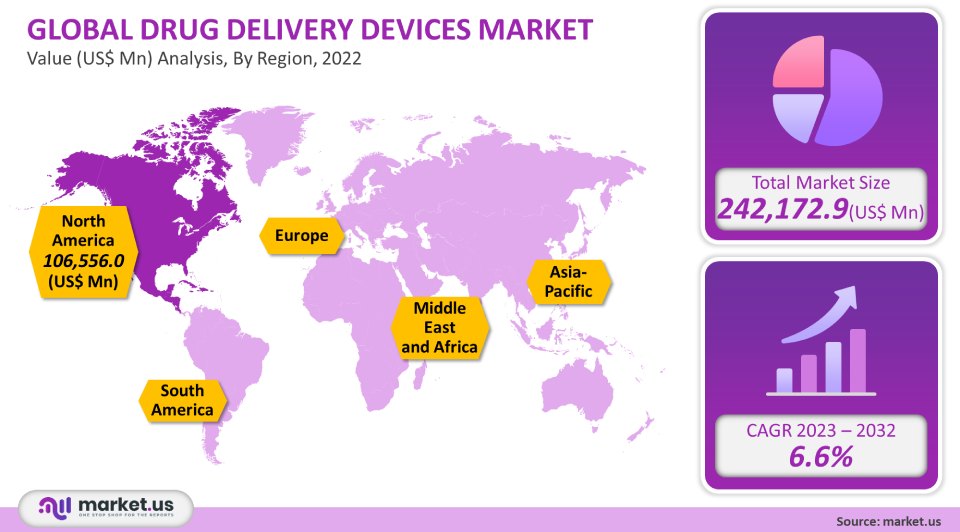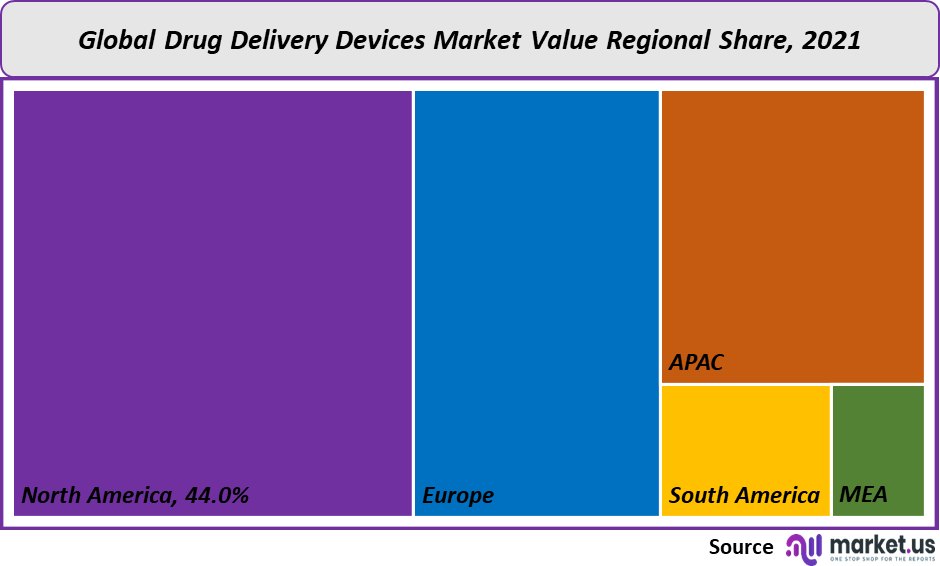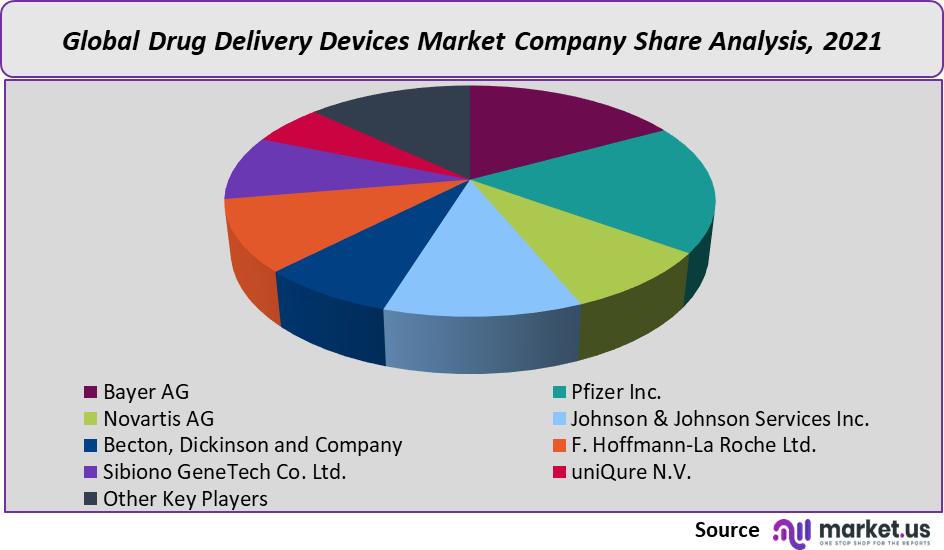Global Drug Delivery Devices Market By Route of Administration (Oral, Inhalation, and Other Route of Administration), By Vehicle (Micelle, Hydrogel, Liposome, and Other Vehicles), By Application (Oncology, Respiratory Diseases, Cardiovascular Diseases, and Other Applications) By End-Use (Diagnostic Centres, Hospitals, Home Care Settings, and Other End-Uses), By Region and Companies - Industry Segment Outlook, Market Assessment, Competition Scenario, Trends and Forecast 2023-2032
- Published date: Nov 2021
- Report ID: 19228
- Number of Pages: 275
- Format:
- keyboard_arrow_up
Drug Delivery Devices Market Overview:
The market for drug delivery devices worldwide was worth USD 242,172.9 million in 2021, and it is projected to grow at a CAGR of 6.6% during the forecast period.
Market growth will be driven by the increasing adoption of advanced technology to effectively deliver the drug to the target location. These devices optimize the drug’s presence at the target site, reducing the chance of side effects. This allows for a reduction in side effects as well as dose. This helps reduce the price of the product by reducing active pharmaceutical ingredients.
Global Drug Delivery Devices Market Analysis:
Route of Administration Analysis
The market can be segmented by route of administration into oral, intradermal, transdermal, and injectable. The intradermal, subcutaneous, and intravenous routes are also available. The oral route of administration accounted for the largest percentage in 2021, and it is expected to continue growing at a rapid pace over the forecast period. There are many dosage options for oral drug delivery, such as solutions, capsules, syrups, tablets, and suspensions. This includes tablets and films. Oral administration is preferred due to its safety, simplicity, cost, and stability. For patients suffering from pulmonary conditions such as asthma or Chronic Obstructive Pulmonary Disorder (COPD), inhalation drug delivery systems are preferable.
The growth of this market will be driven by factors like the rising prevalence of respiratory diseases and technological advancements in inhalation delivery devices such as inhalers and nebulizers. The fastest growth rate for the injectable route is anticipated during the forecast period. The demand for injectable drugs has increased with the introduction of pen injectors and prefilled syringes. Market growth is being driven by polymers and other materials for syringes that are inert to most chemicals.

Vehicles Analysis
The most popular drug delivery vehicle is the liposome. This segment is expected to grow because of its many advantages. The liposome drug delivery vehicle for liposomes is non-immunogenic. It is also biodegradable.
In 2021, hydrogels accounted for a large share of the market. This is due to their porosity, compatibility with an environment aqueous, and attractiveness as a drug delivery vehicle. Hydrogels can also be molded into many forms including microparticles and slabs, nanoparticles as well films, and coatings. These will help increase their adoption for various purposes. The hydrogels have the advantage of allowing for sustained drug delivery to the site. The segment’s growth is expected to be driven by controlled drug delivery via this vehicle.
The fastest expected growth in the forecast period will be for the nanoparticle drug delivery device. The forecast period will see a lot of research and growing interest in nanoparticles for drug delivery. The potential of nanoparticles as drug delivery vehicles is a promise for many applications. Polymeric nanoparticles can be prepared using both hydrophilic and hydrophobic blocks. They are capable of encapsulating both hydrophobic as well as hydrophilic drugs. This structure helps to bind macromolecules, such as proteins, nucleic acids, or antibodies. The forecast period will see a significant increase in the use of nanoparticle drug delivery systems and their development.
Application Analysis
Oncology, infectious disease, respiratory diseases, and diabetes are the main segments of this market. Endocrine disorders and ophthalmic conditions are also included. In 2021, the biggest market share went to diabetes treatment devices in the application segment. This is due to diabetes’s increasing prevalence. The adoption of diabetes drug delivery devices will be influenced by an increase in diabetes cases.
Due to increasing cancer prevalence around the world, the oncology segment held a substantial share of the market. This segment is expected to grow moderately over the forecast period. In the United States, there were approximately 2 million new cancer cases in 2021. Liposomal and albumin drug delivery devices are the two main types used in oncology.The Central Nervous System Disorders (CNS), the segment will experience the fastest growth rate in the forecast period. This segment is expected to grow at a faster rate due to increasing numbers of neurological disorders, such as Parkinson’s, Hunter’s, Alzheimer’s, and brain tumors. To improve the treatment of these neurological conditions, new drug delivery systems are being developed for the CNS. These devices use receptor-ligand interaction and rational drug design to determine the effectiveness of drug delivery at the site.
End Use Analysis
According to end-user, the market is divided into hospitals and diagnostic centers, hospital ambulatory surgery centers/clinics as well as home care settings. Research centers, institutes, universities, and others are also included. Due to the increasing incidence of neurological disorders and cancer, hospitals accounted for the largest percentage in the End-Use segment, in 2021. Hospitalized patients with different disorders need different drugs to treat. Different drug delivery devices can be used. Hospital-acquired Infection is expected to affect the adoption of drug delivery devices in hospitals. This could lead to a decrease in segment growth in the forecast period.
The market also saw a significant amount of share held by diagnostic centers in 2021. Many diagnostic centers focus on the development and adoption of novel drug delivery methods for accurately delivering drugs. Center for Drug Delivery and Nanomedicine (CDDN), focuses on the collection of existing expertise in biomedical sciences research and material for creating a Nanomedicine program and interdisciplinary drugs delivery. The main goal of the center is to improve drug delivery and understand how drugs work.
The fastest expected growth rate for the home care setting segment will be during the forecast period. This segment is expected to grow due to a number of factors, including the growing number of hospital-acquired illnesses, high costs, and longer wait times at hospitals. This trend is driving self-administration to increase the number of treatments in home care settings, as opposed to hospitals and other diagnostic centers.
Key Market Segments:
By Route of Administration
- Oral
- Inhalation
- Injectable
- Nasal
- Other Route of Administration
By Vehicle
- Micelle
- Hydrogel
- Liposome
- Dendrimer
- Other Vehicles
By Application
- Oncology
- Respiratory Diseases
- Cardiovascular Diseases
- Central Nervous System Disorders
- Other Applications
By End-Use
- Diagnostic Centers
- Hospitals
- Home Care Settings
- Ambulatory Surgery Centers/Clinics
- Other End-Uses
Market Dynamics:
Research and development in this field will be boosted by the rising demand for novel drug delivery methods. Strategic alliances are a common practice among major market players to create new technology for various applications. AstraZeneca and Aptamer Group, an international biotechnology company, collaborated to investigate its technology to create a novel drug delivery system for the kidney. Additionally, patients are increasingly able to access drug delivery devices at home due to rising adoption.
To meet the growing demand for drug delivery devices, many companies have developed patient-friendly products. Market players are buying these companies to expand their product portfolio. Aptar Pharma bought Noble International and its drug delivery devices. Noble International has developed advanced drug delivery tools that are patient-centric, such as prefilled needles or auto-injectors. This acquisition will enable patients to safely administer medications using advanced drug delivery equipment.
Current research includes technological advances in drug delivery devices that make them more patient-friendly and accessible. This is why players continue to research new technologies and develop advanced drug delivery devices. Phillips-Medisize was a Molex Company subsidiary. They announced the launch of a combination and electronic-enabled, wearable drug delivery devices. The product is currently in phase three of development and combines single-use disposable technology for subcutaneous drug delivery. The company submitted the New Drug Application (NDA), with key data, to the Food and Drug Administration. Market growth is expected to be driven by the development of highly technologically advanced drug delivery systems.Despite all the advances and advantages associated with these drug delivery systems, there will be some challenges that will impede the market growth. This device has a problem in that it is inefficient in delivering poorly soluble drugs. Other bioavailability barriers of the poorly soluble drug are expected to also impact market growth. Additionally, drug delivery devices could release uncontrolled drugs to the infection site. This can lead to side effects such as allergies and infections.
Regional Analysis:
North America had the largest market share of 44% due to its presence of major players and the increasing adoption of drug delivery systems. The region’s market growth will also be supported by increased awareness about the benefits of drug delivery systems. Market growth is expected to be aided by increased product approvals in countries like the U.S. Aptar Pharma received FDA approval to use its nasal drug delivery system.
Europe accounted for a substantial share of the global market share in 2021 and is expected to grow at a moderate speed. Major market players in the region have access to huge markets because of their developed economies and favorable regulatory frameworks. The Asia Pacific is expected to have the highest growth rate due to its high economic growth. Additionally, the large patient base in countries like India, China, Japan, and China is leading to increased adoption of drug delivery technology by many end-users. Different drug delivery devices are being used in Japan for specific drug types.

Key Regions and Countries covered in thе rероrt:
- North America
- US
- Canada
- Mexico
- Europe
- Germany
- UK
- France
- Italy
- Russia
- Spain
- Rest of Europe
- APAC
- China
- Japan
- South Korea
- India
- Rest of Asia-Pacific
- South America
- Brazil
- Argentina
- Rest of South America
- MEA
- GCC
- South Africa
- Israel
- Rest of MEA
Market Share & Key Players Analysis:
Market players are seeking strategic alliances to expand their product range through partnerships and collaborations. DelSiTech and Bayer, for example, signed a technology licensing agreement to jointly develop and market innovative delivery technology in the area of ophthalmology. SMC Ltd., for its expanded product portfolio, announced the acquisition of Oval Medical Technologies Ltd. The deal included the addition of Oval Medical Technologies Ltd.’s advanced auto-injectors. The market will grow if there are more alliances to develop drug delivery devices.

Маrkеt Кеу Рlауеrѕ:
- Bayer AG
- Pfizer Inc.
- Novartis AG
- Johnson & Johnson Services Inc.
- Becton, Dickinson and Company
- F. Hoffmann-La Roche Ltd.
- Sibiono GeneTech Co. Ltd.
- uniQure N.V.
- Other Key Players
For the Drug Delivery Devices Market research study, the following years have been considered to estimate the market size:
Attribute Report Details Historical Years
2016-2020
Base Year
2021
Estimated Year
2022
Short Term Projection Year
2028
Projected Year
2023
Long Term Projection Year
2032
Report Coverage
Competitive Landscape, Revenue analysis, Company Share Analysis, Manufacturers Analysis, Volume by Manufacturers, Key Segments, Key company analysis, Market Trends, Distribution Channel, Market Dynamics, COVID-19 Impact Analysis, strategy for existing players to grab maximum market share, and more.
Regional Scope
North America, Europe, Asia-Pacific, South America, Middle East & Africa
Country Scope
United States, Canada and Mexico, Germany, France, UK, Russia and Italy, China, Japan, Korea, India and Southeast Asia, Brazil, Argentina, Colombia etc.Saudi Arabia, UAE, Egypt, Nigeria and South Africa
Frequently Asked Questions (FAQ)
What is the size of the Drug Delivery Devices Market in 2021?The Drug Delivery Devices Market size is US$ 242,172.9 million in 2021.
What is the projected CAGR at which the Drug Delivery Devices Market is expected to grow at?The Drug Delivery Devices Market is expected to grow at a CAGR of 6.6% (2023-2032).
List the segments encompassed in this report on the Drug Delivery Devices Market?Market.US has segmented the Drug Delivery Devices Market by geographic (North America, Europe, APAC, South America, and Middle East and Africa). By Route of Administration, the market has been further divided into Oral, Inhalation, Injectable, Nasal, and Other Route of Administration. By Vehicle, the market has been further divided into Micelle, Hydrogel, Liposome, Dendrimer, and Other Vehicles. By Application, the market has been further divided into Oncology, Respiratory Diseases, Cardiovascular Diseases, Central Nervous System Disorders, and Other Applications. By End-Use, the market has been further divided into Diagnostic Centers, Hospitals, Home Care Settings, Ambulatory Surgery Centers/Clinics, and Other End-Uses.
List the key industry players of the Drug Delivery Devices Market?Bayer AG, Pfizer Inc., Novartis AG, Johnson & Johnson Services Inc., Becton, Dickinson and Company, F. Hoffmann-La Roche Ltd., Sibiono GeneTech Co. Ltd., uniQure N.V., and Other Key Players are engaged in the Drug Delivery Devices market
Which region is more appealing for vendors employed in the Drug Delivery Devices Market?North America is expected to account for the highest revenue share of 44%. Therefore, the Drug Delivery Devices industry in North America is expected to garner significant business opportunities over the forecast period.
Name the key areas of business for Drug Delivery Devices?The US, India, China, Canada, UK, Japan, & Germany are key areas of operation for the Drug Delivery Devices Market.
Which segment accounts for the greatest market share in the Drug Delivery Devices industry?With respect to the Drug Delivery Devices industry, vendors can expect to leverage greater prospective business opportunities through the oral route of administration segment, as this area of interest accounts for the largest market share.
![Drug Delivery Devices Market Drug Delivery Devices Market]() Drug Delivery Devices MarketPublished date: Nov 2021add_shopping_cartBuy Now get_appDownload Sample
Drug Delivery Devices MarketPublished date: Nov 2021add_shopping_cartBuy Now get_appDownload Sample - Bayer AG Company Profile
- Pfizer Inc Company Profile
- Novartis AG Company Profile
- Johnson & Johnson Services Inc.
- Becton, Dickinson and Company
- F. Hoffmann-La Roche Ltd.
- Sibiono GeneTech Co. Ltd.
- uniQure N.V.
- Other Key Players
- settingsSettings
Our Clients
|
Single User
$5,999
$2,999
USD / per unit
save 50% |
Multi User
$7,999
$3,499
USD / per unit
save 55% |
Corporate User
$12,999
$4,499
USD / per unit
save 65% | |
|---|---|---|---|
| e-Access | |||
| Data Set (Excel) | |||
| Company Profile Library Access | |||
| Interactive Dashboard | |||
| Free Custumization | No | up to 10 hrs work | up to 30 hrs work |
| Accessibility | 1 User | 2-5 User | Unlimited |
| Analyst Support | up to 20 hrs | up to 40 hrs | up to 50 hrs |
| Benefit | Up to 20% off on next purchase | Up to 25% off on next purchase | Up to 30% off on next purchase |
| Buy Now ($ 2,999) | Buy Now ($ 3,499) | Buy Now ($ 4,499) |









